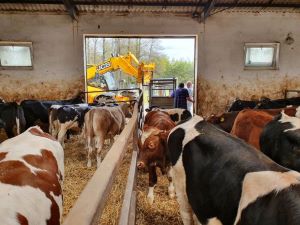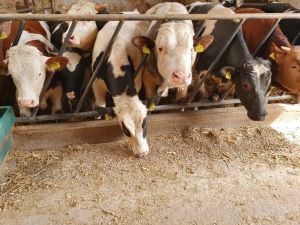A challenge to be addressed was to improve quality of the meat on farm. After a research experiment it was decided to cover it by feeding. Adding supplements to feed as vitamin E and selenium improve color deterioration of beef meat what is appreciated by the slaughterhouse and finally by the consumer. This practice was done in Obory milk and beef farm in Masovia Region, Poland.
The bright red color of fresh meat is due to oxymyoglobin. Over time, oxymyoglobin is oxidized to metmyoglobin and the meat develops brown patches on the surface in a colour deterioration process.
One approach for maintaining oxymyoglobin longer in fresh meat involves enhancement of the reductant pool within muscle by feeding vitamin E, an antioxidant which minimizes oxidation and maximizes reduction of metmyoglobin in the meat.
Six feeding trials at the experimental farms in Poland with Holstain-Friesians bulls indicated that feeding 500 IU of synthetic vitamin E and 100 μg/ kg of feed dry matter of selenium to cattle each day for the last 100 days before slaughter. The diet was roughages and concentrates.

Results showed an improvement colour stability in ground beef and in loin, top-round and sirloin steaks. Vitamin E when fed to beef cattle increased muscle tissue concentrations of alpha-tocopherol, localized in the cell membranes. Increased alpha-tocopherol in the membranes of beef muscle delays the processes of lipid oxidation and metmyoglobin formation (related to meat discoloration) and therefore, lengthens case-life.
Firstly, adding supplements to feeding plan is not difficult as well, it’s not very costly. As final results expected quality of meat was achieved in terms of colour deterioration, but also an improved carcass yield and fatness was found in the trial conducted. All these effects transferred into better economic results of the farm and expectations of delivering same product by beef farmer to slaughterhouse in long-term period. As added value, improvement of animal welfare was observed since the antioxidant in diets reduced health problems.

The good practice was easy to implement and results were really good as colour of beef meat improved. It helps to received better payment for carcass as total classification of carcass increased. It has also some effect on fatness.
Further information
Reviewed material
https://www.researchgate.net/publication/267193531_Manipulating_beef_quality_through_feeding
BKH - The use of antioxidants to extend the shelflife of the meat from intensive finished cattle: https://hub.bovine-eu.net/search/the-use-of-antioxidants-to-extend-the-shelflife-of-the-meat-from-intensive-finished-cattle-